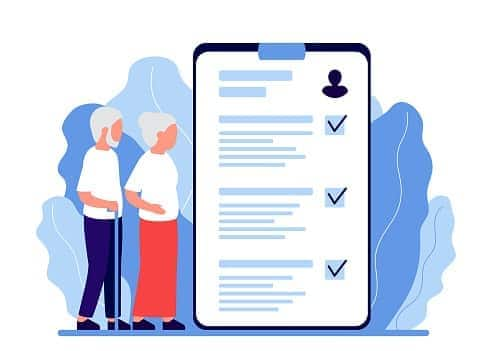PIP vs. MedPay insurance
Both PIP and MedPay cover injuries to you as the driver and any passengers in your car in an accident, no matter who is at fault. However, there are some differences in terms of what they cover, such as how they cover medical expenses resulting from accidents.
What is personal injury protection (PIP)?
PIP insurance provides comprehensive benefits that go beyond simply paying medical bills after an accident. It's comprehensive no-fault coverage that is available immediately after an accident. PIP coverage is required by law in no-fault car insurance states.

PIP coverage varies between states, but can include:
- Medical expenses: Ambulance/paramedic, doctors and surgeons, hospitalization, nursing care, medication, drugs and medical supplies, psychiatric care, imaging, laboratory tests, rehabilitation, prostheses, dental care, optical treatment and chiropractic services. Not all states require 100% reimbursement, and in some cases there is a deductible.
- Funeral expenses: Ceremonies, burial expenses and cremation.
- Lost wages: Some or all of wages lost during recovery. PIP may also cover the cost of temporary employees if you're self-employed.
- Child care and household expenses: PIP can pay for service providers when injuries make it impossible to care for children or maintain the home.
- Survivors’ loss: PIP can cover the breadwinner’s income for surviving dependents.
When you’re injured in an accident, you file a claim with your own insurer for PIP benefits – there’s no need to deal with the other driver’s insurer. Notice that PIP does not compensate you for pain and suffering.
In no-fault states, you can sue the other driver for these and other losses, but only when injuries are deemed severe or when medical expenses meet pre-defined thresholds – you can’t claim pain and suffering for minor injuries.
What is medical payments coverage (MedPay)?
Medical payments coverage (MedPay) is similar to PIP, but much less comprehensive.
It’s optional in all but two states. MedPay covers medical expenses for the insured, other drivers listed on the insurance policy, members of the insured’s household and passengers.
Depending on your state laws, coverage, and insurance company, MedPay can supplement your health insurance coverage or function as primary medical coverage after an accident. If it’s considered supplemental, your health insurance would be used first to cover your injuries, then the MedPay would kick in for deductibles and co-pays. If it’s primary, MedPay is tapped first to cover the immediate medical costs, and then your health coverage takes care of the excess or ongoing expenses.
MedPay is designed to complement standard liability coverage. Some drivers use it to “beef up” their PIP policies. While the coverage is limited, MedPay has a couple of advantages that make it worth considering:
- Pays medical costs quickly, regardless of fault. In a tort state, you’re responsible for your medical costs if you’re at fault. If the other driver is at fault, you may have to fight to get your losses covered. In court, this can take months or even years.
- MedPay has no deductible or co-pay, unlike most health insurance plans.
- You’re covered if injured as someone else’s passenger, if you’re taking public transportation or if you’re injured by another driver while walking or cycling.
How do PIP and MedPay work?
How PIP and MedPay insurance benefits work depends on whether or not the state in which you live is a no-fault or traditional tort liability state.
Most states are tort liability states, and in those, the at-fault driver’s insurer pays the accident victim for property damage and personal injuries. In no-fault states (and three tort liability states), personal injuries are covered by PIP policies. See the map below to determine which states have no-fault laws.
PIP policies do not pay for damage to the cars involved or to other property. In nearly all no-fault states, at-fault drivers (or their insurers) are responsible for damage to other cars or property.
They must purchase liability coverage in addition to PIP, and they need to buy collision coverage if they want damage to their own car covered.
Where are MedPay and PIP required?
PIP is required in all no-fault states, and minimum coverage requirements vary. In addition, PIP is mandatory in Oregon, Delaware and Maryland. When required in a tort state, PIP does not limit the insured’s ability to sue an at-fault driver.
MedPay is required in two tort states, Maine and New Hampshire.
In all other states, both PIP and MedPay are optional.

How much do PIP and MedPay insurance cost?
MedPay is relatively inexpensive, adding about $5 per month to your premium. This is because its use is limited and its maximum payout is low, in the range of $5,000 to $10,000 per person.

The cost of PIP coverage varies a great deal between states. This makes sense when you consider the wide range of mandatory coverage that must be purchased. The chart below shows required coverage for the 12 no-fault states.
Limits range from a low of $2,500 per accident to unlimited medical expenses and permanent injury benefits of $250,000. Because PIP is just one part of the mandatory coverage in no-fault states, its cost isn’t easy to break out. However, it's possible to compare the total average cost of auto insurance in no-fault states and tort states.
- Five PIP-mandatory states, Delaware, Florida, Maryland, New Jersey and Michigan, have average costs that are significantly higher than the national average. Delaware’s are 21% above average, Florida’s premiums are 25% higher, Maryland’s are 21% over, New Jersey’s are 44% higher and Michigan’s are 107% above average, at $2,378 per year.
- Hawaii, Kansas, New York, North Dakota and Utah enjoy much lower than average premiums: Hawaiians pay 21% less, Kansans 14%, New Yorkers 21%, North Dakotans 9% and Utah drivers pay 20% less.
- Drivers in Kentucky, Oregon, Massachusetts, Minnesota, Pennsylvania all pay the national average or very close to it.
According to the Insurance Information Institute, fraud and too-generous payouts have become an issue in several states, including New York, Florida and Michigan. They're probably a factor in the high costs paid by drivers in those states. However, these figures are the total cost of all coverage in states where PIP is required. Optional PIP, added to a standard insurance policy, can be highly affordable, ranging from $20 to $50 a month.
Minimum PIP coverage levels required by state
| State | Coverage |
|---|---|
| Delaware | $15k per person, $30k per accident, $5k funeral |
| Florida | $10k per person |
| Hawaii | $10k per person |
| Kansas | $4.5k per person medical, $4.5k rehab, $2k funeral, $900 per month income, $25 per day for household |
| Kentucky | $10k per person |
| Maryland | $2.5k per accident |
| Massachusetts | $8k per person |
| Michigan | Coverage options include, $50,000, $250,000, $500,000 or lifetime PIP options or to opt out of PIP coverage. To opt out, you must have Medicare Parts A & B and any other household members have an auto policy with PIP or health insurance that covers auto accidents. To get $50,000 of PIP, you must be enrolled in Medicaid and household members must have auto policy with PIP, be on Medicaid or another health insurer. |
| Minnesota | $20k medical, $20k loss of income |
| New Jersey | $15k per person, $250k severe / permanent injury, $2k funeral, 80% lost income up to $2k per month, $25 / day household |
| New York | $50k per person, $2k funeral, 80% lost income to $2k/month, $25 per day household |
| North Dakota | $30k per person |
| Oregon | $15k per person |
| Pennsylvania | $5k per accident |
| Utah | $3k per person, $1.5k funeral, $3k death benefit, $250 / week lost income, $20 / day household |
Doubling up: Does buying both PIP and MedPay make sense?
If you live in a no-fault state, you’re already paying for PIP. Adding MedPay may make little sense because the scope of coverage is narrower than that of PIP.
However, MedPay is cheap, and there are some benefits that you might want. For example, MedPay’s lack of deductible can be a plus, especially if your health insurance policy has a high deductible.
Kevin Lynch, an associate professor of insurance at The American College in Bryn Mawr, Pennsylvania, says that if you already have health insurance, MedPay and PIP may be redundant. Even so, it could still be a worthwhile purchase, he says, because "Your having health insurance is not going to benefit other people in your car if you have an accident," especially if they don't have health insurance. Medical payments coverage can help cover their bills.
In addition, health insurance may not cover all your expenses related to a car accident. For example, deductibles under health insurance policies sold through the Affordable Care Act marketplaces often reach $5,000 or more. Medical payments and PIP would help pay that.
PIP also offers benefits beyond simple health coverage. The lost income reimbursement can be a valuable coverage addition. While short-term and long-term disability policies could compensate you for lost income, Lynch says, they are taxable benefits don’t usually replace 100 percent of your income.
"The PIP coverage is a nontaxable payment and would help you in making up for the difference in lost wages," he says.
Lost income, even for just a few weeks, can severely impact people's finances, says Brooks Gregory, a financial adviser with Peachtree Planning in Atlanta. For that reason, he generally recommends buying the extra insurance. If you can purchase PIP and medical coverage auto insurance inexpensively, it can help protect you in a worst-case scenario, says Gregory.
"It's not the type of coverage that someone needs to get overly excessive with, but for small health claims related to a car accident, it is a great benefit to have.”
Health insurance finder tool

COBRA
Learn more about COBRA
Medicare
Medicare costs vary depending on which option you choose.
Learn more about Medicare costs.
Medicaid

Parent's employer-sponsored health insurance

Spouse's employer-sponsored health insurance

Employer-sponsored health insurance

Preferred-provider Organization (PPOs)
Preferred-provider organization (PPOs) plans are the most common type of
employer-based health plan. PPOs have higher premiums than HMOs and HDHPs, but
those added costs offer you flexibility. A PPO allows you to get care anywhere
and without primary care provider referrals. You may have to pay more to get
out-of-network care, but a PPO will pick up a portion of the costs.
Find out more about the differences between plansHealth maintenance organization (HMO)
Health maintenance organization (HMO) plans have lower premiums than PPOs.
However, HMOs have more restrictions. HMOs don't allow you to get care outside
of your provider network. If you get out-of-network care, you'll likely have to
pay for all of it. HMOs also require you to get primary care provider referrals
to see specialists.
Find out more about the differences between plansHigh-deductible health plans (HDHPs)
High-deductible health plans (HDHPs) have become more common as employers look
to reduce their health costs. HDHPs have lower premiums than PPOs and HMOs, but
much higher deductibles. A deductible is what you have to pay for health care
services before your health plan chips in money. Once you reach your deductible,
the health plan pays a portion and you pay your share, which is called
coinsurance.
Find out more about the differences between plansExclusive provider organization (EPO)
Exclusive provider organization (EPO) plans offer the flexibility of a PPO with
the restricted network found in an HMO. EPOs don't require that members get a
referral to see a specialist. In that way, it's similar to a PPO. However, an
EPO requires in-network care, which is like an HMO.
Find out more about the differences between plans
Learn more about individual insurance plans
How to file a MedPay or PIP claim
After an accident, you will contact your car insurance company and the adjuster there will help you to determine which of the benefits on your policy apply.
You don't need to file a separate MedPay claim or a separate PIP claim. If those coverages apply, they will kick in automatically.
Health care providers may bill the car insurance company directly. If they bill you instead, you can request reimbursement from the auto insurer.
The auto insurance company may also work with your health insurance company to cover the bills.
Make sure you keep track of all of your medical expenses, so you can get full reimbursement from the car insurance company.
States with two-part medical bill limits are set up so injured drivers with health insurance have PIP pick up a smaller amount of the medical bills and the health insurance pays the remainder.
Your adjuster and health insurance company will help you to navigate the billing process.














